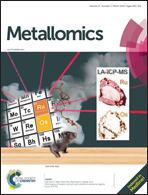Combined brain Fe, Cu, Zn and neurometabolite analysis – a new methodology for unraveling the efficacy of transcranial direct current stimulation (tDCS) in appetite control†
Abstract
Obesity is a chronic, multifactorial origin disease that has recently become one of the most frequent lifestyle disorders. Unfortunately, current obesity treatments seem to be ineffective. At present, transcranial direct current brain stimulation (tDCS) represents a promising novel treatment methodology that seems to be efficient, well-tolerated and safe for a patient. Unfortunately, the biochemical action of tDCS remains unknown, which prevents its widespread use in the clinical arena, although neurobiochemical changes in brain signaling and metal metabolism are frequently reported. Therefore, our research aimed at exploring the biochemical response to tDCS in situ, in the brain areas triggering feeding behavior in obese animals. The objective was to propose a novel neurochemical (serotoninergic and dopaminergic signaling) and trace metal analysis of Fe, Cu and Zn. In doing so, we used energy-dispersive X-ray fluorescence (EDXRF) and high-performance liquid chromatography (HPLC). Anodal-type stimulation (atDCS) of the right frontal cortex was utilized to down-regulate food intake and body weight gain in obese rats. EDXRF was coupled with the external standard method in order to quantify the chemical elements within appetite-triggering brain areas. Major dopamine metabolites were assessed in the brains, based on the HPLC assay utilizing the external standard assay. Our study confirms that elemental analysis by EDXRF and brain metabolite assay by HPLC can be considered as a useful tool for the in situ investigation of the interplay between neurochemical and Fe/Cu/Zn metabolism in the brain upon atDCS. With this methodology, an increase in both Cu and Zn in the satiety center of the stimulated group could be reported. In turn, the most significant neurochemical changes involved dopaminergic and serotoninergic signaling in the brain reward system.



 Please wait while we load your content...
Please wait while we load your content...